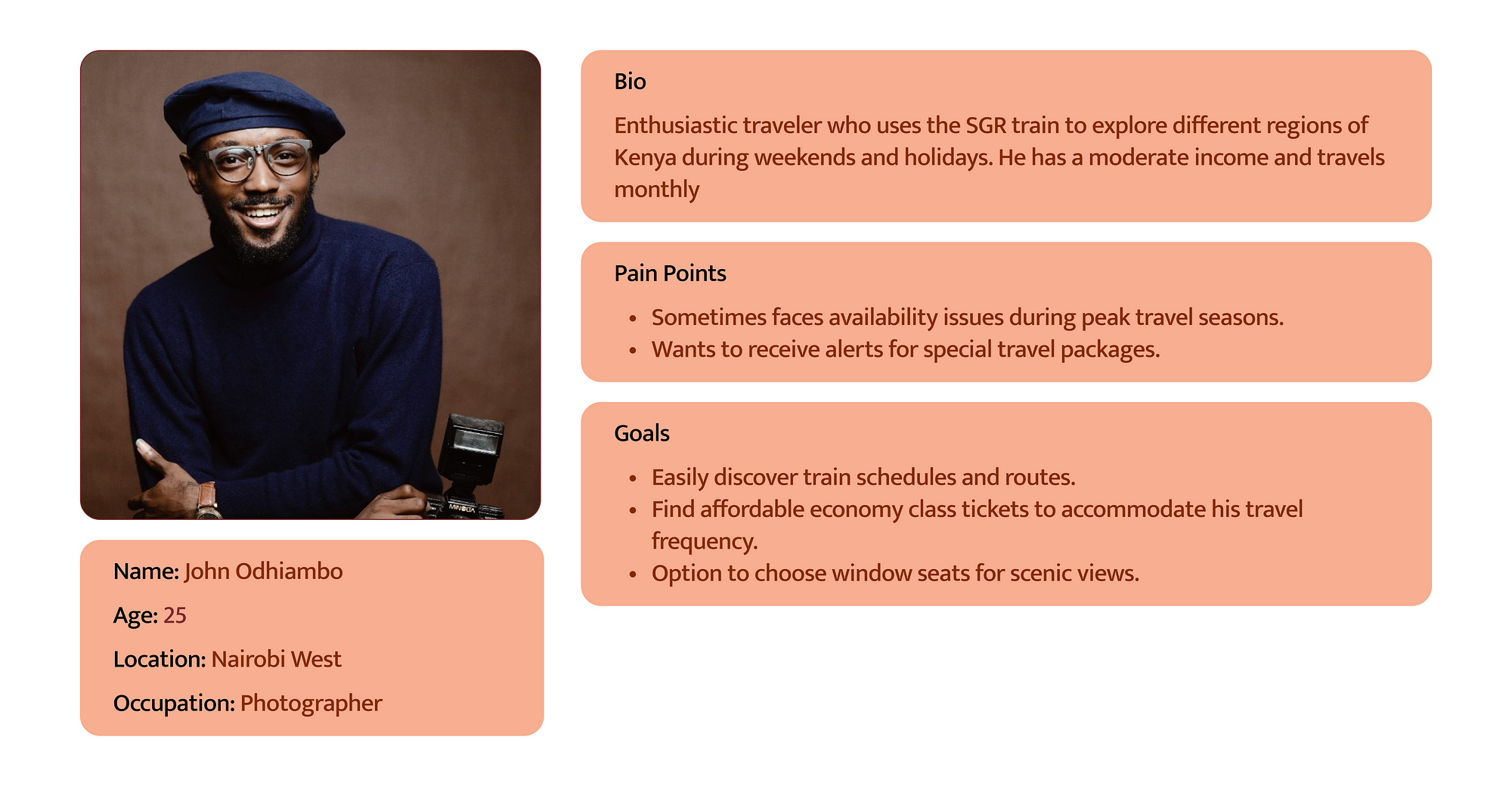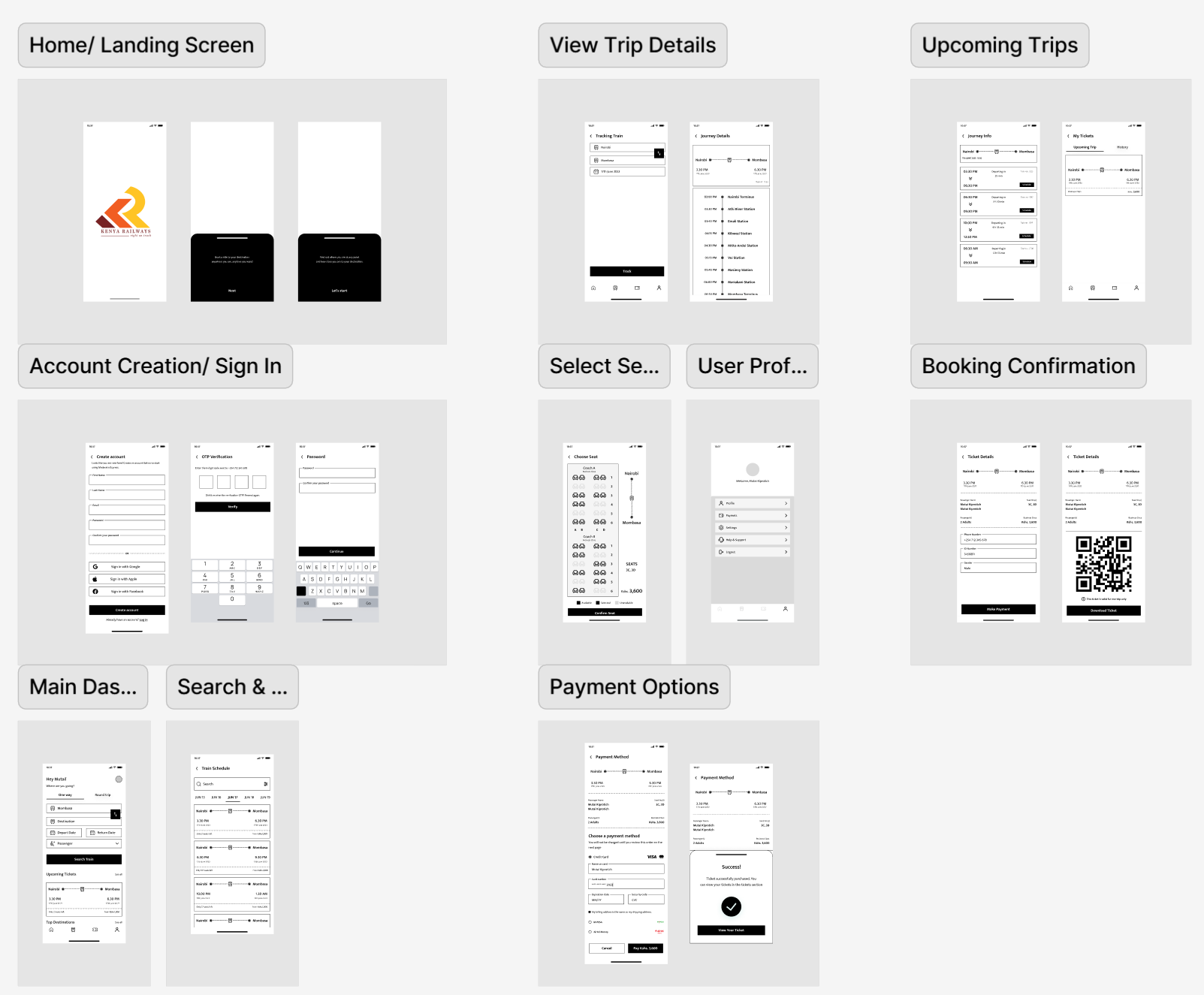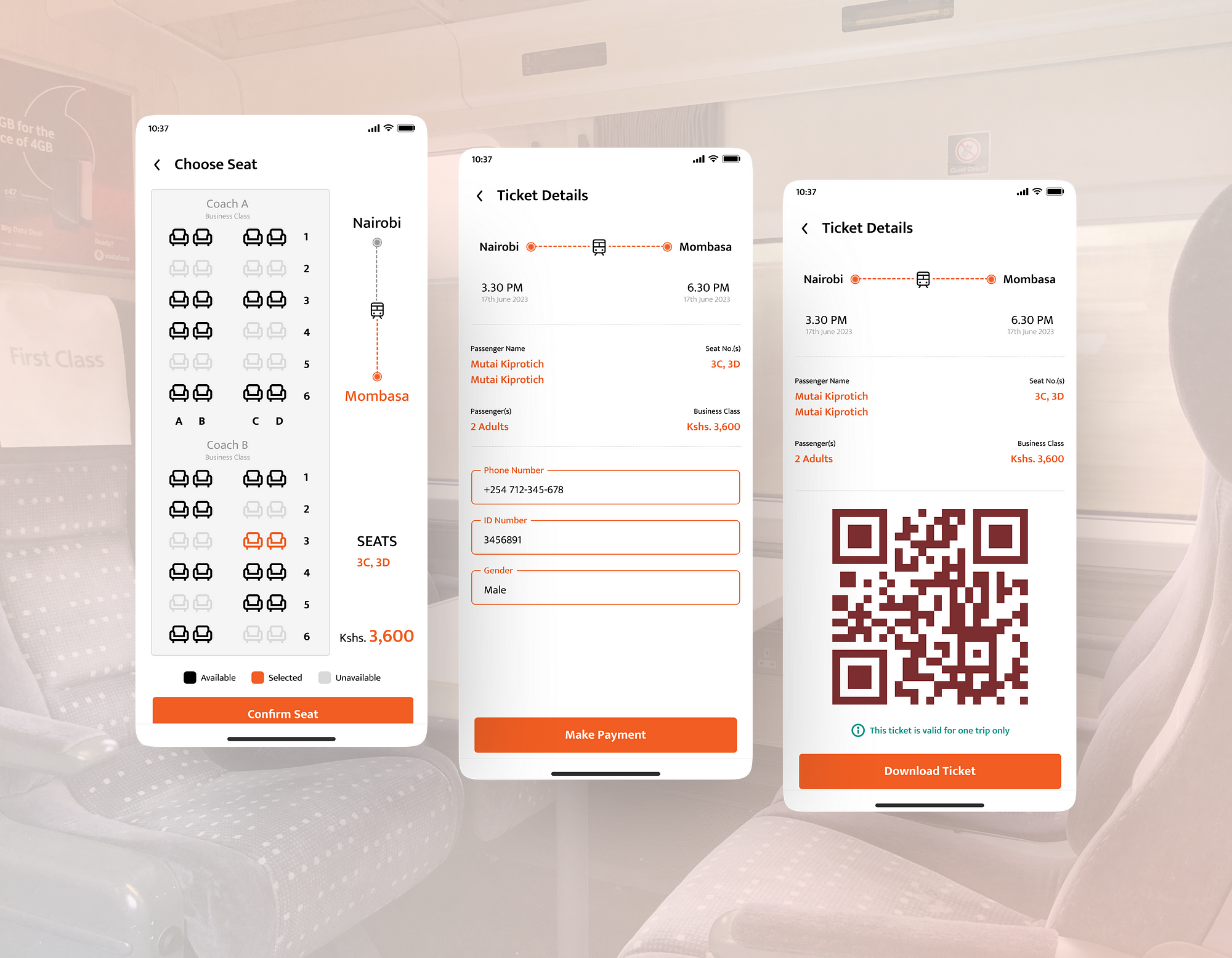Note*: This is a personal project. I was **NOT** in a contract or paid by Kenya Railways Corporation to design this mobile app.*
What is the Madaraka Express SGR Train Ticketing App?
Madaraka Express SGR Train Ticketing App simply allows you to catch your train, verify your ticket, and also have ease in traveling to and from different parts of Kenya. Quickly book your ticket and avail yourself to the train station and as simple as that, you are sorted.
INTRODUCTION
In an era where seamless travel experiences and user-centric solutions are paramount, I embarked on a journey to enhance the ticketing process for the Madaraka Express Standard Gauge Railway (SGR) train in Kenya.
This case study unveils the meticulous design process I undertook to create a user-friendly and efficient train ticketing app that caters to the diverse needs of the modern travelers who use it.
The Madaraka Express SGR train has redefined long-distance travel in Kenya, offering speed, comfort, and convenience. However, the ticketing process posed challenges for passengers, ranging from confusing interfaces to limited accessibility.
My aim was clear: to revolutionize the way passengers interact with the ticketing system, making their journey not only comfortable on the train but also seamless from the moment they decide to travel.
This case study delves into the journey of crafting an intuitive, visually appealing, and accessible UI/UX design for the Madaraka Express SGR train ticketing app. From understanding the pain points faced by travelers to refining the user flow and creating a visually consistent interface, I meticulously worked towards simplifying the entire ticket booking process.
By adhering to user-centered design principles and leveraging cutting-edge UI/UX practices, I set out to create an app that not only streamlines ticket purchasing, but also enhances the overall travel experience. Throughout this case study, I will walk you through my design process, showcasing how it led to a comprehensive and user-friendly solution.
The results obtained from this project will demonstrate not only a marked improvement in the app’s usability and accessibility but also a positive impact on the overall passenger experience. As I delve into the intricacies of this design journey, I invite you to explore how thoughtful UI/UX design can transform the way we travel, making it as memorable as the destination itself.
My Role: UI/UX Designer
Scope: Primary/Secondary Research, Design Thinking, User Flow, Wireframing & Design Style-guide
Timeline: 2 months
Tools: Figma, Google Docs, Miro
Problem Statement:
On the official website, booking a ticket is quite seamless, albeit on a desktop, but then again, not everyone has 24/7 access to one of these devices. Now, this is where smartphones come in to play, you can book that ticket quickly and easily with an app right on your phone! An easy-to-use UI makes the whole experience enjoyable, plus new features to make your life similarly easier.
DESIGN PROCESS
- Research and Discovery
User Research
I drafted a user interview script using Google Docs. This script aims to gather insights into the user experience of the Madaraka Express SGR train ticketing app. Participants are asked about their familiarity with the SGR train, booking preferences, challenges faced, desired features, and suggestions for improvement.
The interview covers topics such as ease of booking, online vs. station booking preferences, user profiles, ticket types and offers, seat selection, payment methods, notifications, app improvements, user experience enhancements, and additional services.
The closing emphasizes gratitude for participation and highlights the value of feedback for enhancing the app’s user experience, providing contact information for future input.
Critical Pain Points
Limited Availability
Complex Payment Process
Confusing Interface
Lack of Flexibility
Communication Gaps
Unclear Policies
Limited Support
Critical User Needs
Efficient Booking Process
Clear Schedule Information
Seat Selection
Payment Convenience
Real-time Notifications
User Profiles
Accessibility
Contextual Analysis
Let’s now look at who is set to benefit if this app goes live. A mixed demographic uses the SGR train. Their characteristics can include age, income level, occupation, education, nationality, and purpose of travel. The demographics are likely quite diverse due to the varied purposes for which people use the train.
Tourists and Travelers: Tourists and travelers, both domestic and international, use the Madaraka Express SGR train to explore Kenya’s various cities and landscapes. These individuals may vary in age, nationality, and travel purposes.
Business Travelers: Business professionals frequently use the SGR train for business trips between Nairobi and Mombasa, as well as other cities along the route. This demographic segment may include individuals from various industries and job roles.
Commuters: Commuters who work in one city and reside in another use the SGR train for their daily travel. This can include individuals commuting between Nairobi and its surrounding areas.
Students: Students studying in cities along the SGR route may use the train to travel between their home and educational institutions.
Leisure Travelers: Leisure travelers use the SGR train for weekend getaways, vacations, and visits to family and friends. This demographic can vary widely in terms of age, occupation, and travel frequency.
Local Residents: Residents of cities along the SGR route might also use the train for leisure trips or special occasions, contributing to a diverse range of demographics.



2. Design Goals and Principles:
Simplicity and Ease of Use: Prioritizing a simple and intuitive user interface that allows users to navigate the app and book tickets with minimal effort and without confusion.
Efficiency in Booking: Designing the app to facilitate quick and hassle-free ticket booking, enabling users to complete the process in as few steps as possible.
Accessibility and Inclusivity: Ensuring the app is accessible to all users, including those with disabilities, by adhering to accessibility standards and providing features that assist users with different needs.
Clear Information Presentation: Presenting train schedules, ticket options, and pricing information in a clear and organized manner, aiding users in making informed decisions.
Personalization: Incorporating user-profiles and preferences to provide personalized experiences, such as saved payment methods and favorite routes, enhancing convenience.
Visual Appeal and Consistency: Creating a visually appealing design with consistent branding elements, typography, colors, and imagery, reinforcing a cohesive and memorable user experience.
Real-time Updates: Implementing real-time notifications to keep users informed about booking confirmations, departures, delays, and any changes to their journey.
Mobile-Friendly Design: Optimizing the app for mobile devices, ensuring responsive design, touch-friendly interactions, and easy usability on smaller screens.
Usability Testing: Conduct thorough usability testing with real users to identify pain points, gather feedback, and make iterative improvements based on user insights.
Error Prevention and Recovery: Implementing mechanisms to prevent errors during booking, and offer clear solutions and guidance in case users encounter issues.
Ethical Considerations: Respecting user privacy and data security by following best practices in data handling and obtaining user consent where required.
3. Ideation



4. High-fidelity Design






5. Style-guide

CONCLUSION
My journey in designing this app was a captivating blend of innovation and user-centered thinking. By meticulously addressing the unique needs of Kenyan travelers and aligning them with the iconic SGR brand, I created an experience that not only simplifies ticket booking but also captures the spirit of contemporary travel.
My design approach harmonizes intuitive navigation with vibrant visuals, making tasks like exploring schedules, choosing seats, and making payments a joyful experience. Through thorough user testing and iterative improvement, I crafted an app accessible to both tech-savvy users and newcomers, fostering inclusivity.
This case study underscores the value of user research and data-driven choices. The design is more than pixels; it is a narrative that unfolds with every interaction. My journey continues; it is an ongoing evolution. As we move forward, I will persistently refine, enrich, and innovate, always driven by the mission of providing a travel experience as smooth as the ride itself.
The project can be found on Behance: https://www.behance.net/gallery/164606523/Madaraka-Express-SGR-Train-Ticketing-App
Reach out and connect: mutaicollinskiprotich@gmail.com

